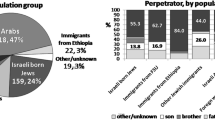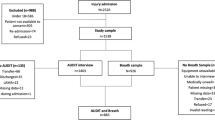Summary
Background
Violence as well as alcohol-attributable injuries is a dominant public health issue worldwide. Victims, being injured, frequently visit emergency rooms (ER).
Methods
We interviewed all the patients seeking help in an urban emergency room reporting being victims of violent behavior over a period of 3 months (from November 2011 to January 2012).
Results
Our results showed that 1 out of 23 patients seeking help in our ER was due to forcible means. A total of 15 % of all victims reported domestic violence (75 % women) and others (90 % men) reported brawl as the reason for seeking help. Overall, 80 % of the victims were younger than 40 years. In case of domestic violence, two-third (only women) reported that they were hurt by their intimate partner. At total of 50 % were treated for head wounds and 35 % had injuries of their extremities. One-third of the patients were alcoholized. The victims of brawls mainly suffer from head injuries (69 %). Half of this patient group was under the influence of alcohol.
Conclusions
To conclude, victims of violence seek for help in emergency rooms daily. Alcohol consumption is the main factor for violent behavior. Public health programs to prevent alcohol related violence and therefore, alcohol-attributable injuries have to be implemented. Addressing the need to enhance the awareness of the health professionals has to be an imperative.
Zusammenfassung
Grundlagen
Gewalt und Verletzungen, die dem Einfluss von Alkohol zuzuschreiben sind, sind weltweit ein großes Public Health Problem. Die Opfer werden häufig in den Notaufnahmen einer Unfallchirurgie medizinisch versorgt werden.
Methodik
Wir haben über einen Zeitraum von drei Monaten (November 2011 bis Januar 2012) in einer städtischen Notaufnahme all jene PatientInnen interviewt, die angaben, dass sie Opfer von gewalttätigem Verhalten sind.
Ergebnisse
Unsere Ergebnisse haben gezeigt, dass eine/-r von 23 PatientInnen aufgrund von äußerer Gewalteinwirkung medizinische Hilfe benötigt. 15 % aller Opfer (75 % Frauen) beanspruchen Hilfe aufgrund von häuslicher Gewalt, die anderen (90 % Männer) hauptsächlich aufgrund von Raufhandel. Insgesamt waren 80 % der Opfer jünger als 40 Jahre. Im Fall von häuslicher Gewalt gaben zwei Drittel (nur Frauen) an, dass sie von ihrem Lebenspartner verletzt wurden. 50 % wurden aufgrund von Kopfverletzungen versorgt, 35 % litten an Verletzungen an den Extremitäten. Ein Drittel der PatientInnen war alkoholisiert. Die meisten Opfer von Raufhandel litten an Kopfverletzungen (69 %) und die Hälfte von ihnen war alkoholisiert.
Schlussfolgerungen
Zusammenfassend werden Opfer von Gewalt täglich in der Notaufnahme medizinisch versorgt. Public Health Programme, die Gewalt und alkoholbedingte Verletzungen verhindern, müssten implementiert werden. Das medizinische Personal für dieses Problem zu sensibilisieren ist dringend erforderlich.


Similar content being viewed by others
References
Brzank P, Blättner B. Screening nach Gewalt gegen Frauen durch den Partner. Internationale Diskussion, Überlegungen für Deutschland. Bundesgesundheitsblatt. 2010;53:221–32.
Krug EG, Dahlberg LL, Mercy JA, Zwi AB, Lozano R, editors. World report on violence and health. Geneva: World Health Organization; 2002.
Kapella O, Baierl A, Rille-Pfeiffer C, Geserick C, Schmidt E.-M, Schröttle M. Gewalt in der nahen Familie und im sozialen Umfeld. Österreichisches Institut für Familienforschung an der Universität Wien. 2011. http://www.oif.ac.at/publikationen/weitere_publikationen/detail/?tx_ttnews[tt_news]=2410&cHash=c2c1cc73679b1211963100a4a911aade. Accessed 29 May 2012.
Wild M. Häusliche Gewalt – Der unfallchirurgische Blick. Deutscher Kongress für Orthopädie und Unfallchirurgie, 21.–24. 10. 2009, Berlin; 2009.
Prekker ME, Miner JR, Rockswold EG, Biros MH. The prevalence of injury of any type in an urban emergency department population. J Trauma. 2009;66(6):1688–95.
World Health Organisation. World report on violence and health. 2002. http://www.who.int/violence_injury_prevention/violence/world_report/en/summary_ge.pdf. Accessed 29 May 2012.
Cherpitel CJ, Ye Y, Bond J, Borges G, Chou P, Nilsen P, Ruan J, Xiang X. Multi-level analysis of alcohol-related injury and drinking patterns: emergency data from 19 countries. Addiction. 2012;107:1263–72.
Rehm J, Taylor B, Patra J. Volume of alcohol consumption, patterns of drinking and burden of disease in the European region 2002. Addiction. 2006;101:1086–95.
Leonard KE. Alcohol and intimate partner violence: when can we say that heavy drinking is a contributing cause of violence? Editorial. Addiction. 2005;100:422–5.
Hoskins R, Benger J. What is the burden of alcohol-related injuries in an inner city emergency department? Emerg Med J. 2012. doi:10.1136/emermed-2011-200510.
Ferns T. Recording violent incidents in the emergency department. Nurs Stand. 2012;26(28):40–8.
Choo EK, McGregor AJ, Mello MJ, Baird J. Gender, violence and brief interventions for alcohol in the emergency department. Drug Alcohol Depend. 2013;127(1–3):115–21.
Haller B, Dawid E. Kosten häuslicher Gewalt in Österreich. 2006. http://www.ikf.ac.at/a_proj06/a_pro03.htm. Accessed 29 May 2012.
Hellbernd H, Brzank P, Wieners K, Maschewsky-Schneider U. Häusliche Gewalt gegen Frauen: gesundheitliche Versorgung. Das S.I.G.N.A.L.-Interventionsprogramm. Handbuch für die Praxis. Wissenschaftlicher Bericht. 2004.
Statistik Austria, editor. Gerichtliche Kriminalstatistik. Wien: Statistik Austria; 2012.
Conflict of interest
The authors declare no conflict of interest.
Author information
Authors and Affiliations
Corresponding author
Rights and permissions
About this article
Cite this article
Burkert, N., Rásky, É., Freidl, W. et al. Female and male victims of violence in an urban emergency room—prevalence, sociodemographic characteristics, alcohol intake, and injury patterns. Wien Klin Wochenschr 125, 134–138 (2013). https://doi.org/10.1007/s00508-013-0329-z
Received:
Accepted:
Published:
Issue Date:
DOI: https://doi.org/10.1007/s00508-013-0329-z




